Electrical Characterization of Through-Silicon-via-Based Coaxial Line for High-Frequency 3D Integration (Invited Paper)
Abstract
:1. Introduction
2. Theories of Coaxial TSVs
3. Coaxial-like TSVs
4. Conclusions
Author Contributions
Funding
Data Availability Statement
Acknowledgments
Conflicts of Interest
Abbreviations
| TSV | Through-silicon-via |
| 3D | Three dimensional |
| RF | Radio frequency |
| MEMS | Microelectromechanical Systems |
| S-G | Signal-ground |
| DRIE | Deep reactive ion etching |
| AR | Aspect ratio |
| BCB | Benzocyclobutene |
| ABF | Ajinomoto Build-up Film |
| p.u.l | per-unit-length |
| TEM | Transverse Electromagnetic |
| FEM | Finite Element Method |
References
- Liu, X.; Sun, Q.; Huang, Y.; Chen, Z.; Liu, G.; Zhang, D.W. Optimization of TSV leakage in via-middle tsv process for wafer-level packaging. Electronics 2021, 10, 2370. [Google Scholar] [CrossRef]
- Ait Belaid, K.; Belahrach, H.; Ayad, H. Numerical laplace inversion method for through-silicon via (TSV) noise coupling in 3D-IC design. Electronics 2019, 8, 1010. [Google Scholar] [CrossRef] [Green Version]
- Tian, W.; Ma, T.; Liu, X. TSV technology and high-energy heavy ions radiation impact review. Electronics 2018, 7, 112. [Google Scholar] [CrossRef] [Green Version]
- Kim, J.; Pak, J.S.; Cho, J.; Song, E.; Cho, J.; Kim, H.; Song, T.; Lee, J.; Lee, H.; Park, K.; et al. High-frequency scalable electrical model and analysis of a through silicon via (TSV). IEEE Trans. Compon. Packag. Manuf. Technol. 2011, 1, 181–195. [Google Scholar]
- Xiong, W.; Dong, G.; Wang, Y.; Zhu, Z.; Yang, Y. 3-D Compact marchand balun design based on through-silicon via technology for monolithic and 3-D integration. IEEE Trans. Very Large Scale Integr. (VLSI) Syst. 2022, 30, 1107–1118. [Google Scholar] [CrossRef]
- Wang, Z. 3-D integration and through-silicon vias in MEMS and microsensors. J. Microelectromech. Syst. 2015, 24, 1211–1244. [Google Scholar] [CrossRef]
- Xu, Z.; Lu, J.Q. Three-dimensional coaxial through-silicon-via (TSV) design. IEEE Electron Device Lett. 2012, 33, 1441–1443. [Google Scholar] [CrossRef]
- Adamshick, S.; Coolbaugh, D.; Liehr, M. Feasibility of coaxial through silicon via 3D integration. Electron. Lett. 2013, 49, 1028–1030. [Google Scholar] [CrossRef]
- Jung, D.H.; Kim, H.; Kim, S.; Kim, J.J.; Bae, B.; Kim, J.; Yook, J.M.; Kim, J.C.; Kim, J. 30 Gbps high-speed characterization and channel performance of coaxial through silicon via. IEEE Microw. Wirel. Compon. Lett. 2014, 24, 814–816. [Google Scholar] [CrossRef]
- Wu, W.C.; Chang, E.Y.; Hwang, R.B.; Hsu, L.H.; Huang, C.H.; Karnfelt, C.; Zirath, H. Design, fabrication, and characterization of novel vertical coaxial transitions for flip-chip interconnects. IEEE Trans. Adv. Packag. 2009, 32, 362–371. [Google Scholar]
- Ho, S.W.; Rao, V.S.; Khan, O.K.N.; Yoon, S.U.; Kripesh, V. Development of coaxial shield via in silicon carrier for high frequency application. In Proceedings of the 2006 8th Electronics Packaging Technology Conference, Singapore, 6–8 December 2006; pp. 825–830. [Google Scholar]
- Yook, J.M.; Kim, Y.G.; Kim, W.; Kim, S.; Kim, J.C. Ultrawideband signal transition using quasi-coaxial through-silicon-via (TSV) for mm-wave IC packaging. IEEE Microw. Wirel. Compon. Lett. 2020, 30, 167–169. [Google Scholar] [CrossRef]
- Qian, L.; Xia, Y.; He, X.; Qian, K.; Wang, J. Electrical modeling and characterization of silicon-core coaxial through-silicon vias in 3-D integration. IEEE Trans. Compon. Packag. Manuf. Technol. 2018, 8, 1336–1343. [Google Scholar] [CrossRef]
- Shen, W.W.; Chen, K.N. Three-dimensional integrated circuit (3D IC) key technology: Through-silicon via (TSV). Nanoscale Res. Lett. 2017, 12, 56. [Google Scholar] [CrossRef] [PubMed] [Green Version]
- Yu, L.; Yang, H.; Jing, T.T.; Xu, M.; Geer, R.; Wang, W. Electrical characterization of RF TSV for 3D multi-core and heterogeneous ICs. In Proceedings of the 2010 IEEE/ACM International Conference on Computer-Aided Design (ICCAD), San Jose, CA, USA, 7–11 November 2010; pp. 686–693. [Google Scholar]
- Yook, J.M.; Kim, J.C.; Park, S.H.; Ryu, J.I.; Park, J.C. High density and low-cost silicon interposer using thin-film and organic lamination processes. In Proceedings of the 2012 IEEE 62nd Electronic Components and Technology Conference, San Diego, CA, USA, 29 May–1 June 2012; pp. 274–278. [Google Scholar]
- Malta, D.; Vick, E.; Goodwin, S.; Gregory, C.; Lueck, M.; Huffman, A.; Temple, D. Fabrication of TSV-based silicon interposers. In Proceedings of the 2010 IEEE International 3D Systems Integration Conference (3DIC), Munich, Germany, 16–18 November 2010; pp. 1–6. [Google Scholar]
- Bao, X.; Ocket, I.; Bao, J.; Doijen, J.; Zheng, J.; Kil, D.; Liu, Z.; Puers, B.; Schreurs, D.; Nauwelaers, B. Broadband dielectric spectroscopy of cell cultures. IEEE Trans. Microw. Theory Tech. 2018, 66, 5750–5759. [Google Scholar] [CrossRef]
- Bao, X.; Wang, L.; Wang, Z.; Zhang, J.; Zhang, M.; Crupi, G.; Zhang, A. Simple, fast, and accurate broadband complex permittivity characterization algorithm: Methodology and experimental validation from 140 GHz up to 220 GHz. Electronics 2022, 11, 366. [Google Scholar] [CrossRef]
- Ho, S.W.; Yoon, S.W.; Zhou, Q.; Pasad, K.; Kripesh, V.; Lau, J.H. High RF performance TSV silicon carrier for high frequency application. In Proceedings of the 2008 58th Electronic Components and Technology Conference, Lake Buena Vista, FL, USA, 27–30 May 2008; pp. 1946–1952. [Google Scholar]
- Chen, X.; Tang, J.; Xu, G.; Luo, L. Process development of a novel wafer level packaging with TSV applied in high-frequency range transmission. Microsyst. Technol. 2013, 19, 483–491. [Google Scholar] [CrossRef]
- Lee, W.C.; Min, B.W.; Kim, J.C.; Yook, J.M. Silicon-core coaxial through silicon via for low-loss RF Si-interposer. IEEE Microw. Wirel. Compon. Lett. 2017, 27, 428–430. [Google Scholar] [CrossRef]
- Farooq, M.; Graves-Abe, T.; Landers, W.; Kothandaraman, C.; Himmel, B.; Andry, P.; Tsang, C.; Sprogis, E.; Volant, R.; Petrarca, K.; et al. 3D copper TSV integration, testing and reliability. In Proceedings of the 2011 International Electron Devices Meeting, Washington, DC, USA, 5–7 December 2011; pp. 1–7. [Google Scholar]
- Hummler, K.; Smith, L.; Caramto, R.; Edgeworth, R.; Olson, S.; Pascual, D.; Qureshi, J.; Rudack, A.; Quon, R.; Arkalgud, S. On the technology and ecosystem of 3D/TSV manufacturing. In Proceedings of the 2011 IEEE/SEMI Advanced Semiconductor Manufacturing Conference, Saratoga Springs, NY, USA, 16–18 May 2011; pp. 1–6. [Google Scholar]
- Tippet, J.C.; Chang, D.C. Characteristic impedance of a rectangular coaxial line with offset inner conductor. IEEE Trans. Microw. Theory Tech. 1978, 26, 876–883. [Google Scholar] [CrossRef]
- Bao, X.; Crupi, G.; Ocket, I.; Bao, J.; Ceyssens, F.; Kraft, M.; Nauwelaers, B.; Schreurs, D. Numerical modeling of two microwave sensors for biomedical applications. Int. J. Numer. Model. Electron. Netw. Devices Fields 2021, 34, e2810. [Google Scholar] [CrossRef]
- Lukic, M.; Rondineau, S.; Popovic, Z.; Filipovic, S. Modeling of realistic rectangular/spl mu/-coaxial lines. IEEE Trans. Microw. Theory Tech. 2006, 54, 2068–2076. [Google Scholar] [CrossRef]
- Bao, X.; Ocket, I.; Bao, J.; Liu, Z.; Puers, B.; Schreurs, D.M.P.; Nauwelaers, B. Modeling of coplanar interdigital capacitor for microwave microfluidic application. IEEE Trans. Microw. Theory Tech. 2019, 67, 2674–2683. [Google Scholar] [CrossRef]
- Gugliandolo, G.; Tabandeh, S.; Rosso, L.; Smorgon, D.; Fernicola, V. Whispering gallery mode resonators for precision temperature metrology applications. Sensors 2021, 21, 2844. [Google Scholar] [CrossRef] [PubMed]
- Gugliandolo, G.; Naishadham, K.; Donato, N.; Neri, G.; Fernicola, V. Sensor-integrated aperture coupled patch antenna. In Proceedings of the 2019 IEEE International Symposium on Measurements & Networking (M&N), Catania, Italy, 8–10 July 2019; pp. 1–5. [Google Scholar]
- Gugliandolo, G.; Aloisio, D.; Campobello, G.; Crupi, G.; Donato, N. Development and metrological evaluation of a microstrip resonator for gas sensing applications. In Proceedings of the 24th IMEKO TC-4 International Symposium, Palermo, Italy, 14–16 September 2020; pp. 14–16. [Google Scholar]
- Bao, X.; Liu, S.; Ocket, I.; Bao, J.; Kil, D.; Zhang, S.; Cheng, C.; Feng, K.; Avolio, G.; Puers, B.; et al. Coplanar waveguide for dielectric material measurements at frequencies from 140 GHz to 220 GHz. In Proceedings of the 90th ARFTG Conference Digest, Boulder, CO, USA, 28 November–1 December 2017; pp. 1–4. [Google Scholar]
- Bao, X.; Liu, S.; Ocket, I.; Liu, Z.; Schreurs, D.M.; Nauwelaers, B.K. A modeling procedure of the broadband dielectric spectroscopy for ionic liquids. IEEE Trans. NanoBiosci. 2018, 17, 387–393. [Google Scholar] [CrossRef] [PubMed]
- Ong, N. Microwave cavity-perturbation equations in the skin-depth regime. J. Appl. Phys. 1977, 48, 2935–2940. [Google Scholar] [CrossRef]
- Costamagna, E.; Fanni, A. Characteristic impedances of coaxial structures of various cross section by conformal mapping. IEEE Trans. Microw. Theory Tech. 1991, 39, 1040–1043. [Google Scholar] [CrossRef]
- Li, Q.; Zhang, Y.; Qu, L.; Fan, Y. Quasi-static analysis of multilayer dielectrics filled coaxial line using conformal mapping method. In Proceedings of the 2018 IEEE International Conference on Computational Electromagnetics (ICCEM), Chengdu, China, 26–28 March 2018; pp. 1–3. [Google Scholar]
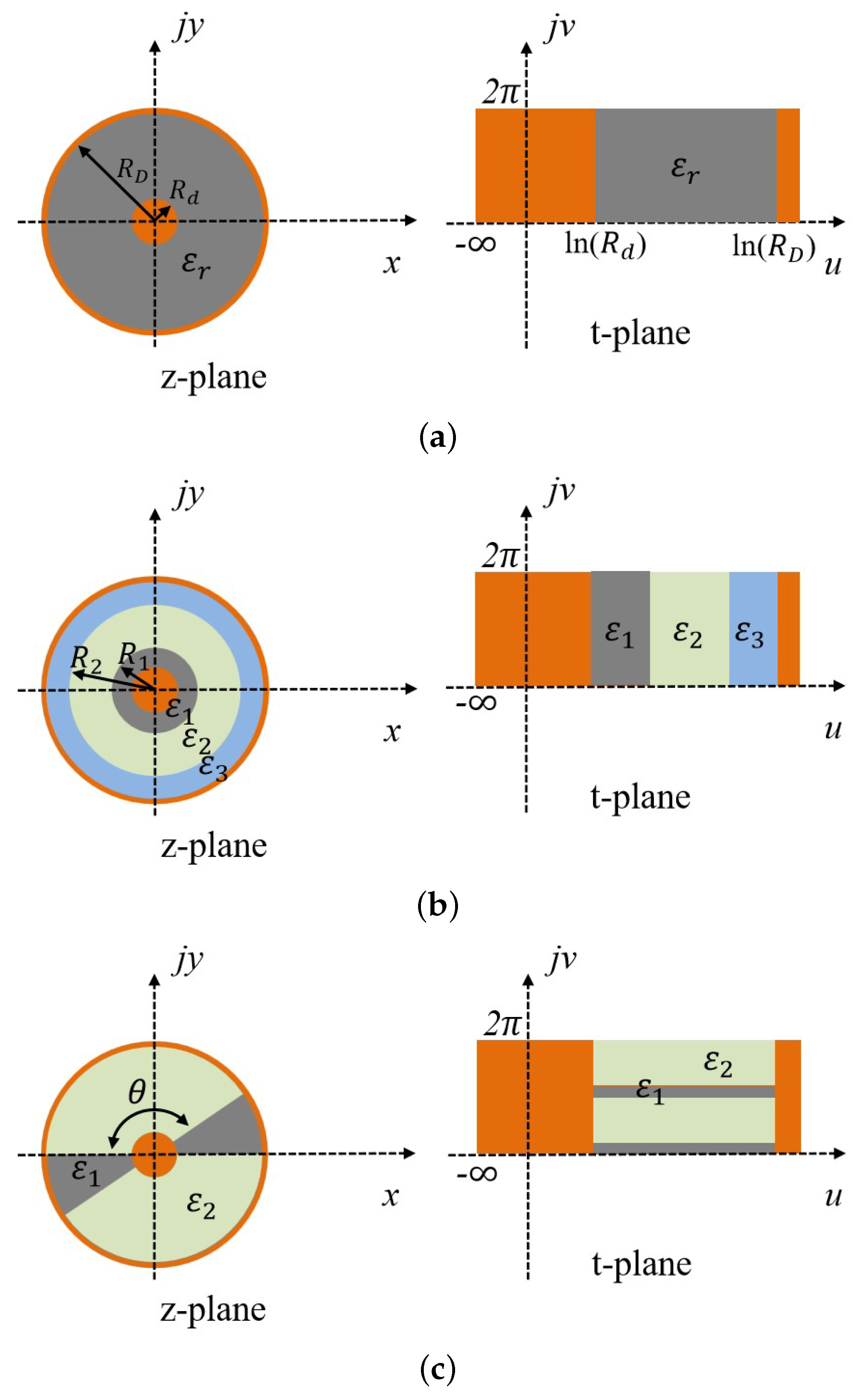
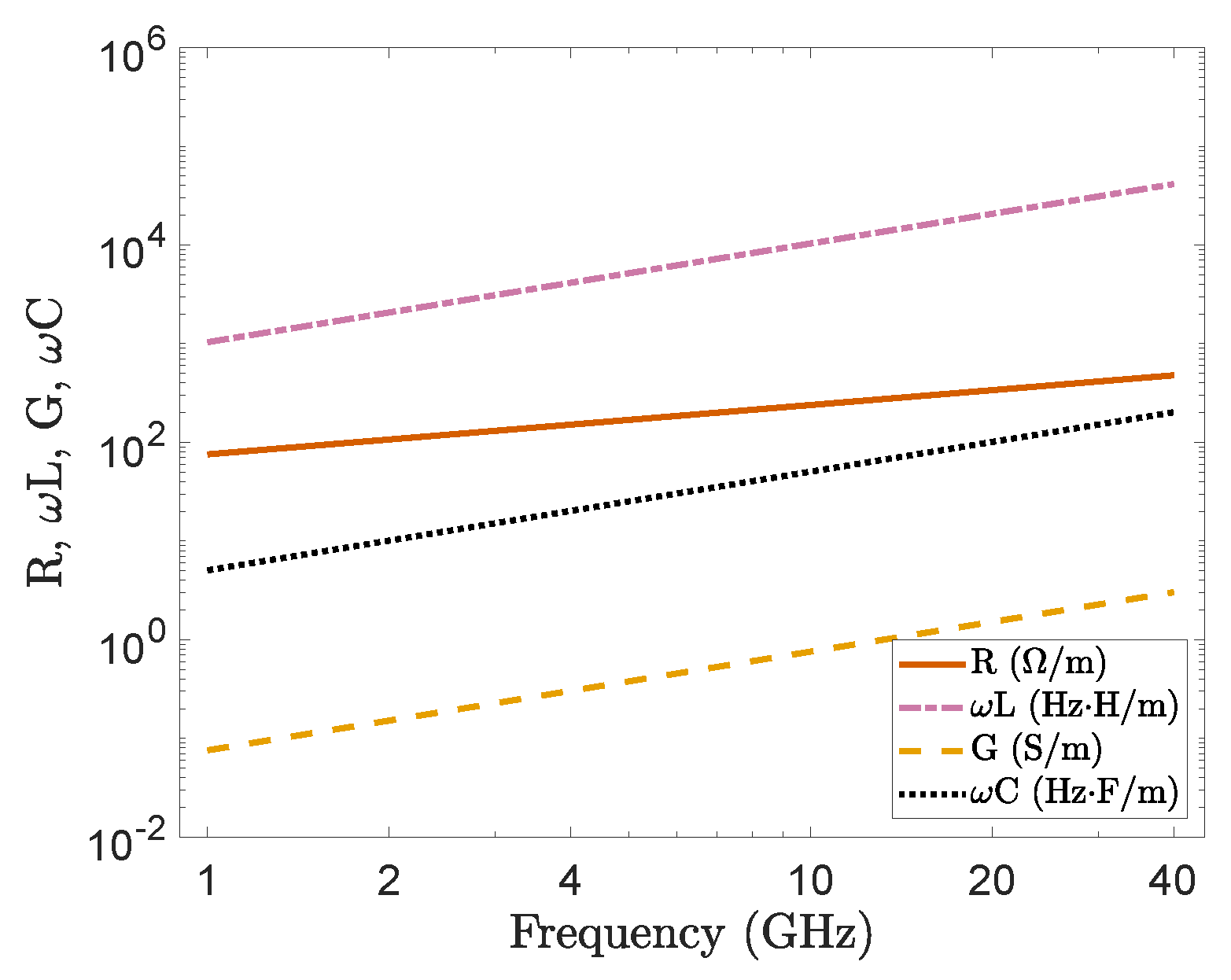

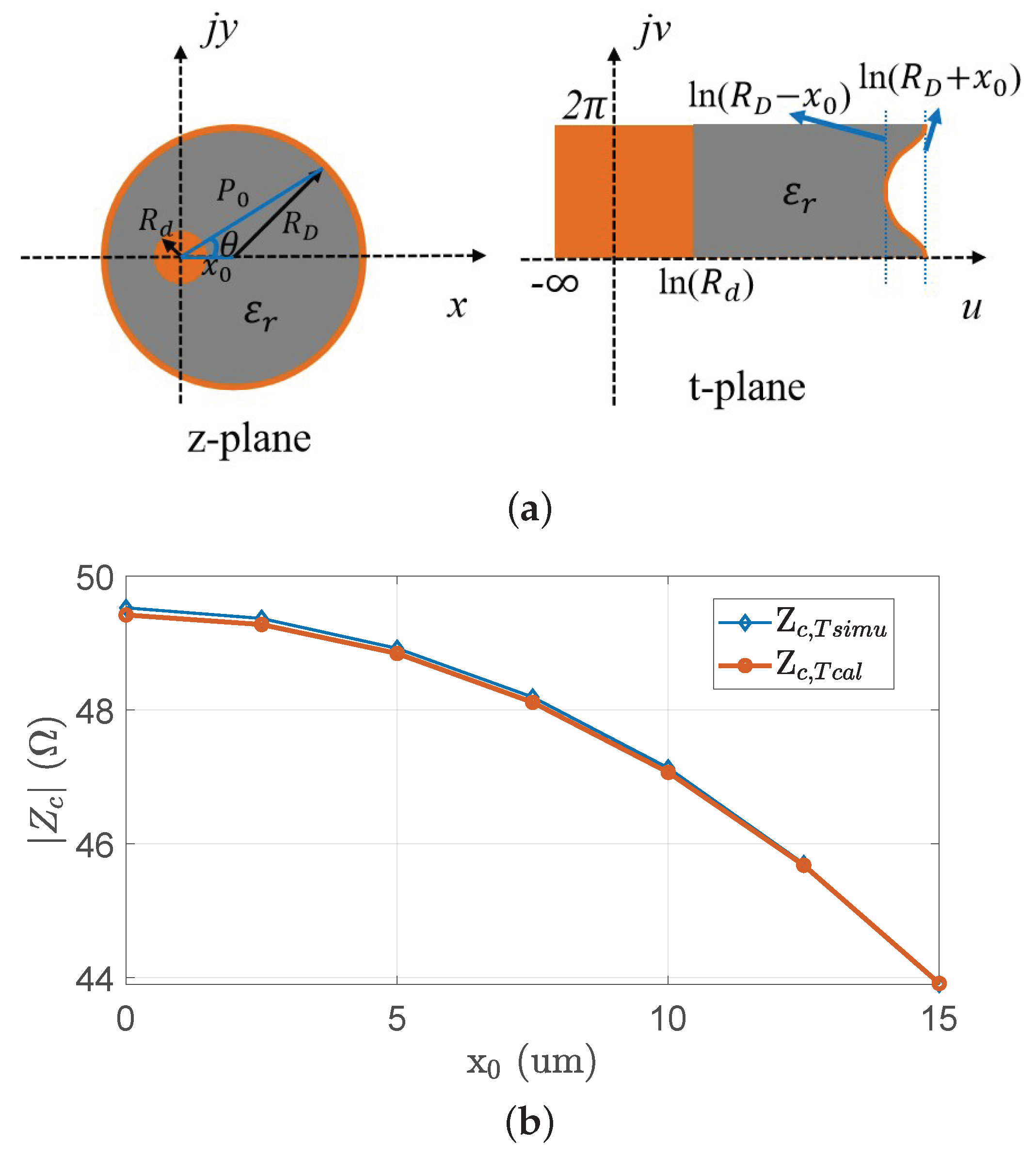
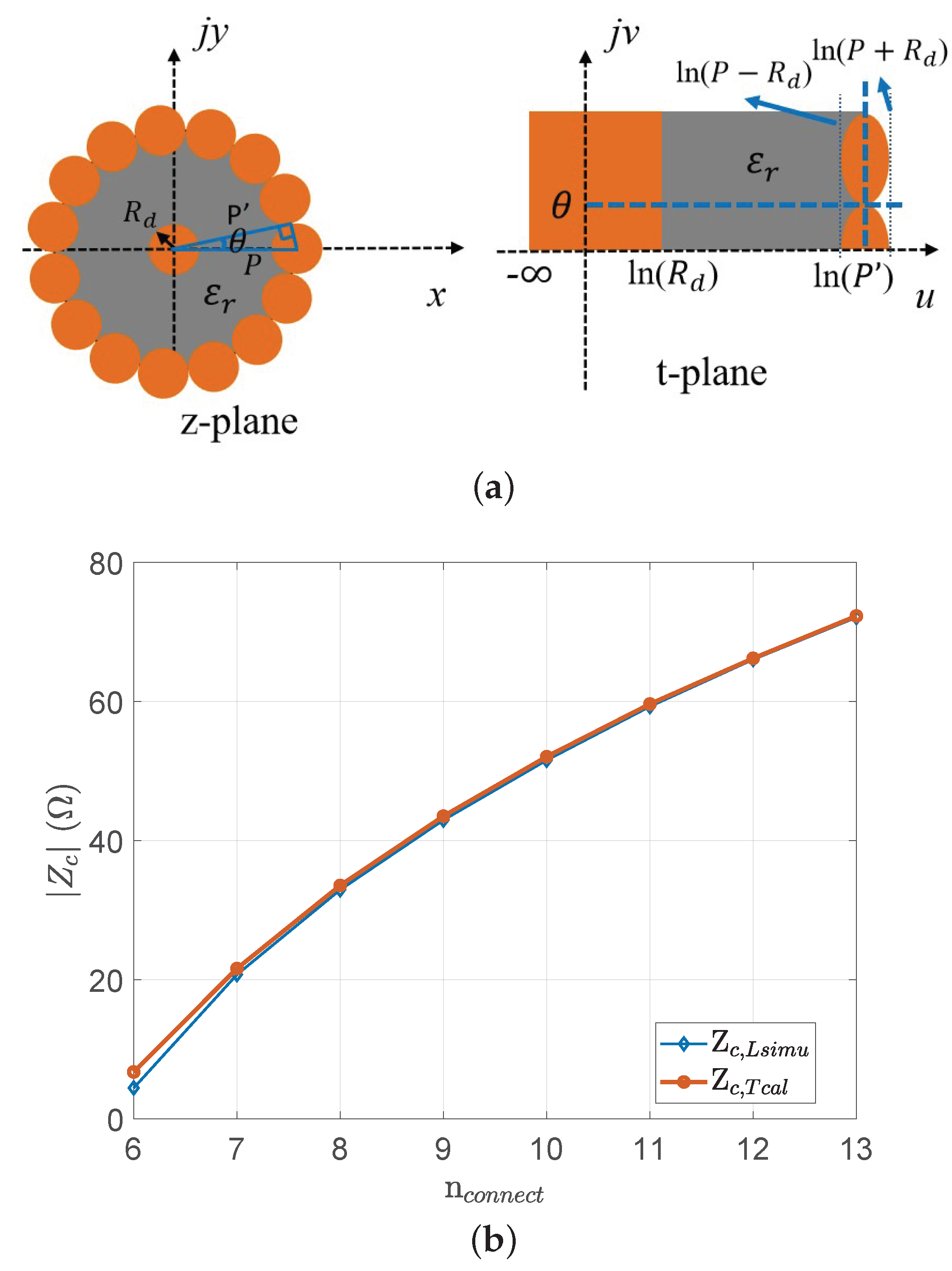
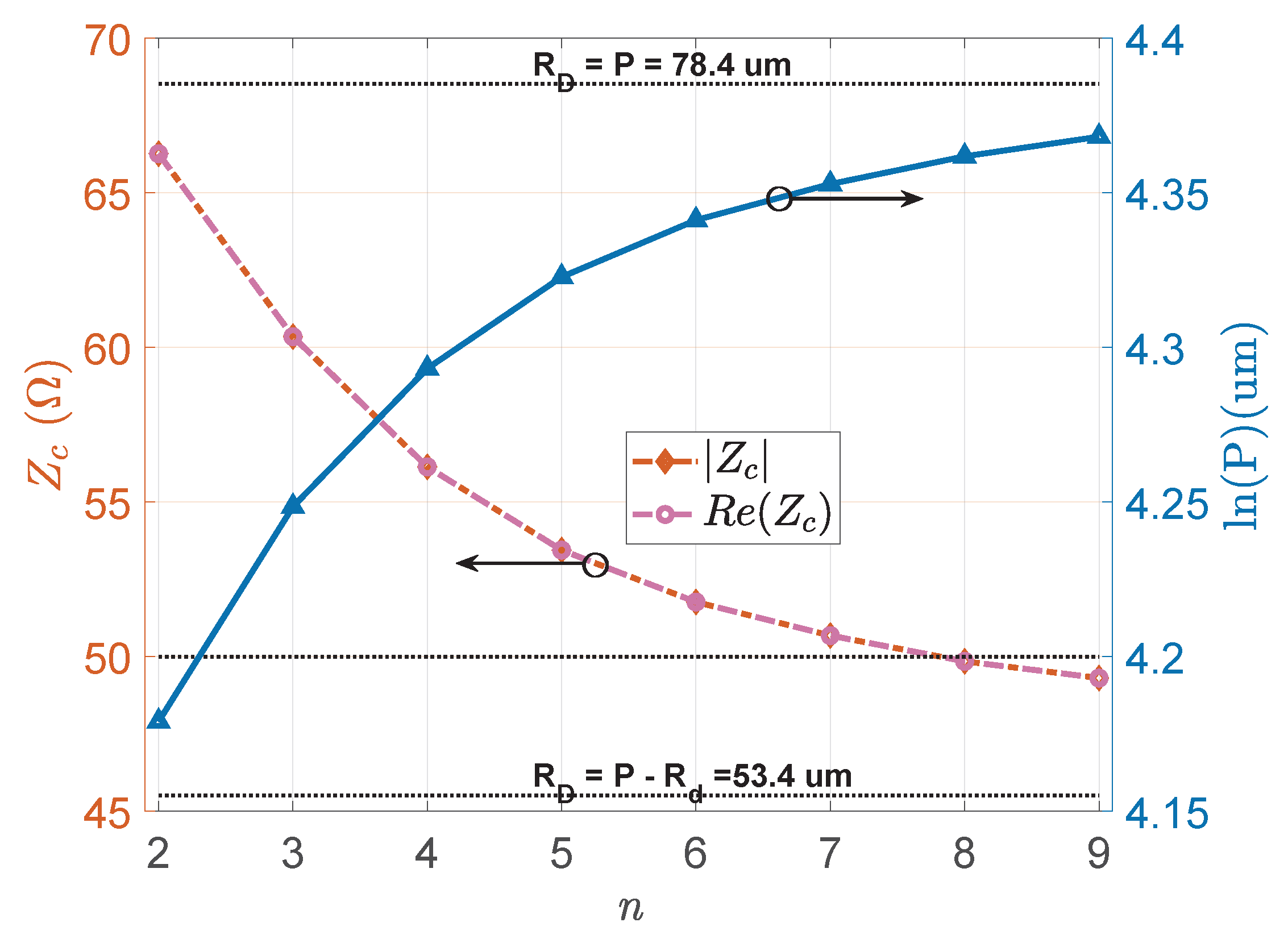
| n | 6 | 7 | 8 | 9 | 10 | 11 | 12 | 13 |
|---|---|---|---|---|---|---|---|---|
| P (m) | 50.00 | 57.62 | 65.33 | 73.10 | 80.90 | 88.74 | 96.59 | 104.46 |
| (m) | 28.12 | 36.02 | 43.74 | 51.64 | 59.55 | 67.57 | 75.39 | 83.44 |
| () | 7.05 | 21.89 | 33.54 | 43.50 | 52.05 | 59.61 | 66.18 | 72.26 |
Publisher’s Note: MDPI stays neutral with regard to jurisdictional claims in published maps and institutional affiliations. |
© 2022 by the authors. Licensee MDPI, Basel, Switzerland. This article is an open access article distributed under the terms and conditions of the Creative Commons Attribution (CC BY) license (https://creativecommons.org/licenses/by/4.0/).
Share and Cite
Zhao, Z.; Li, J.; Yuan, H.; Wang, Z.; Gugliandolo, G.; Donato, N.; Crupi, G.; Si, L.; Bao, X. Electrical Characterization of Through-Silicon-via-Based Coaxial Line for High-Frequency 3D Integration (Invited Paper). Electronics 2022, 11, 3417. https://doi.org/10.3390/electronics11203417
Zhao Z, Li J, Yuan H, Wang Z, Gugliandolo G, Donato N, Crupi G, Si L, Bao X. Electrical Characterization of Through-Silicon-via-Based Coaxial Line for High-Frequency 3D Integration (Invited Paper). Electronics. 2022; 11(20):3417. https://doi.org/10.3390/electronics11203417
Chicago/Turabian StyleZhao, Zhibo, Jinkai Li, Haoyun Yuan, Zeyu Wang, Giovanni Gugliandolo, Nicola Donato, Giovanni Crupi, Liming Si, and Xiue Bao. 2022. "Electrical Characterization of Through-Silicon-via-Based Coaxial Line for High-Frequency 3D Integration (Invited Paper)" Electronics 11, no. 20: 3417. https://doi.org/10.3390/electronics11203417









